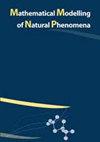Analysis of dynamic evolution process of the $N$-player division of labor game model
IF 2.1
4区 数学
Q2 MATHEMATICAL & COMPUTATIONAL BIOLOGY
引用次数: 0
Abstract
This paper investigates a three-strategy (cooperators, toxin producers, and cheaters) $N$-player division of labor game in bacterial populations. We construct the replicator equation to discuss the evolution of the frequency of the three strategies. Firstly, we prove that the interior equilibrium is always unstable, the three strategies cannot coexist. Secondly, according to Sotomayor's theorem, the system undergoes transcritical bifurcation. Furthermore, the sensitivity of the two-dimensional evolutionary state diagrams to the third parameter (toxin rate, absorption rate, toxin quantity, etc) is analyzed. In summary, high toxicity rates, high levels of toxins, and low levels of competition tend to promote cooperation. All players choose to perform the task, and the cheater disappears. When the absorption rate of cooperators is high enough, only cooperators exist in the population over time. When the absorption rate of the cooperator is low, and the absorption rate of the toxin producer is greater than the threshold, the cooperator and the toxin producer coexist. All players perform the task. Finally, the triangle diagrams and three-dimensional diagrams are presented, which show the initial conditions of the three strategies also affect the dynamic results. As the amount of toxin increases, the range of players who choose to perform tasks widens.$N$-玩家分工博弈模型的动态演化过程分析
本文研究了细菌种群中的一个三策略(合作者、毒素制造者和骗子)N人分工博弈。我们构造了复制因子方程来讨论这三种策略的频率演变。首先,我们证明了内部均衡总是不稳定的,三种策略不能共存。其次,根据索托马约尔定理,系统发生了跨临界分岔。进一步分析了二维演化状态图对第三个参数(毒素率、吸收率、毒素量等)的敏感性。总之,高毒性率、高毒素水平和低竞争水平倾向于促进合作。所有玩家都选择执行任务,作弊者消失。当合作者的吸收率足够高时,随着时间的推移,种群中只存在合作者。当合作者的吸收率较低,而毒素产生者的吸收率大于阈值时,合作者与毒素产生者共存。所有玩家都要完成这个任务。最后给出了三角图和三维图,说明了三种策略的初始条件也会影响动态结果。随着毒素数量的增加,玩家选择执行任务的范围也会扩大。
本文章由计算机程序翻译,如有差异,请以英文原文为准。
求助全文
约1分钟内获得全文
求助全文
来源期刊

Mathematical Modelling of Natural Phenomena
MATHEMATICAL & COMPUTATIONAL BIOLOGY-MATHEMATICS, INTERDISCIPLINARY APPLICATIONS
CiteScore
5.20
自引率
0.00%
发文量
46
审稿时长
6-12 weeks
期刊介绍:
The Mathematical Modelling of Natural Phenomena (MMNP) is an international research journal, which publishes top-level original and review papers, short communications and proceedings on mathematical modelling in biology, medicine, chemistry, physics, and other areas. The scope of the journal is devoted to mathematical modelling with sufficiently advanced model, and the works studying mainly the existence and stability of stationary points of ODE systems are not considered. The scope of the journal also includes applied mathematics and mathematical analysis in the context of its applications to the real world problems. The journal is essentially functioning on the basis of topical issues representing active areas of research. Each topical issue has its own editorial board. The authors are invited to submit papers to the announced issues or to suggest new issues.
Journal publishes research articles and reviews within the whole field of mathematical modelling, and it will continue to provide information on the latest trends and developments in this ever-expanding subject.
 求助内容:
求助内容: 应助结果提醒方式:
应助结果提醒方式:


